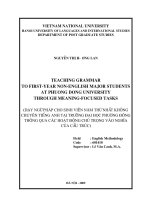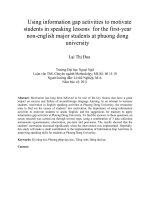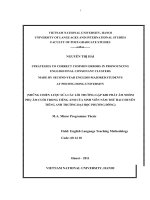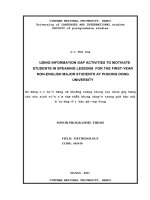Using information gap activitives to motivate students in speaking lessons for the first-year non-English major students at Phuong Dong University
Bạn đang xem bản rút gọn của tài liệu. Xem và tải ngay bản đầy đủ của tài liệu tại đây (449.84 KB, 6 trang )
VIETNAM NATIONAL UNIVERSITY, HANOI
University of LANGUAGES AND INTERNATIONAL studies
FACULTY of postgraduate studies
Lại Thị Đua
USING INFORMATION GAP ACTIVITIES TO MOTIVATE
STUDENTS IN SPEAKING LESSONS FOR THE FIRST-YEAR
NON-ENGLISH MAJOR STUDENTS AT PHUONG DONG
UNIVERSITY
Sử dụng các hoạt động có khoảng trống thông tin nhằm gây hứng
thú cho sinh viên năm thứ nhất không chuyên trong giờ học nói
ở tr-ờng đại học ph-ơng đông
MINOR PROGRAMME THESIS
FIELD: METHODOLOGY
CODE: 601410
HANOI 2011
VIETNAM NATIONAL UNIVERSITY, HANOI
University of LANGUAGES AND INTERNATIONAL studies
FACULTY of postgraduate studies
Lại thị đua
USING INFORMATION GAP ACTIVITIES TO MOTIVATE
STUDENTS IN SPEAKING LESSONS FOR THE FIRST-YEAR
NON-ENGLISH MAJOR STUDENTS AT PHUONG DONG
UNIVERSITY
Sử dụng các hoạt động có khoảng trống thông tin nhằm gây hứng
thú cho sinh viên năm thứ nhất không chuyên trong giờ học nói
ở tr-ờng đại học ph-ơng đông
MINOR PROGRAMME THESIS
FIELD: METHODOLOGY
CODE: 601410
SUPERVISOR: lê thế
nghiệp, MA
HANOI 2011
4
TABLE OF CONTENTS
DECLARATION ............................................................................................................... i
ABSTRACT ...................................................................................................................... ii
ACKNOWLEDGEMENTS .............................................................................................. iii
TABLE OF CONTENTS ................................................................................................. iv
LIST OF CHARTS........................................................................................................... vi
PART ONE: INTRODUCTION .................................................................. 1
1. Rationale of the study ............................................................................................... 1
2. Aims and objectives of the study ............................................................................... 2
3. Scope of the study ..................................................................................................... 2
4. Methodology of the study .......................................................................................... 2
5. Research hypothesis .................................................................................................. 2
6. Design of the study .................................................................................................... 3
PART TWO: DEVELOPMENT ................................................................. 4
CHAPTER 1: LITERATURE REVIEW ....................................................................... 4
1.1. Teaching speaking ................................................................................................ 4
1.1.1. Concepts of speaking ....................................................................................... 4
1.1.2. The role of speaking in foreign language teaching ............................................ 4
1.1.3. Factors affecting English speaking ability ........................................................ 6
1.2 Information gap activities...................................................................................... 6
1.2.1. Concept of information gap activities ............................................................... 7
1.2.1.1. Concept of information gap ........................................................................... 7
1.2.1.2. Concept of information gap activities ............................................................ 7
1.2.2. Benefits of information gap activities ............................................................... 8
1.2.3. Teachers’ roles in information gap activities .................................................... 9
1.2.4. Forms of information gap activities ................................................................ 10
1.2.5. Some popular information gap activities ........................................................ 11
CHAPTER 2: THE STUDY
2.1. An action research .............................................................................................. 13
2. 2. Research questions ............................................................................................. 13
2.3. The informants .................................................................................................... 13
2. 4. The action research procedure .......................................................................... 14
5
2. 5. Description of Data Collection Instruments ..................................................... 16
2.5.1. Questionnaires ......................................................................................................... 16
2.5.2. Observations ............................................................................................................ 17
2.5.3. Tests ............................................................................................................ 17
CHAPTER 3: DATA ANALYSIS AND DISCUSSIONS............................................. 18
3.1. Data collected from preliminary investigation stage – Questionnaire 1 ........................ 18
3.1.1. Students’ attitude towards speaking skill .................................................................. 18
3.1.2 Factors causing students’ low motivation in speaking English .................................. 20
3.2. Intervention ......................................................................................................... 21
3.2.1. The aims of the intervention ..................................................................................... 21
3.2.2. The intervention of information gap activities .............................................. 21
3.3. Data collected from the intervention stage ........................................................ 26
3.3.1. Data collected from Observation sheets .................................................................... 26
3.3.2. Data collected from Questionnaire 2............................................................. 27
3.3.2. Data collected from the tests ........................................................................ 29
3.3.2. Data from pre-test ........................................................................................ 29
3.3.2. Data from post-test ....................................................................................... 30
PART THREE: CONCLUSION AND SUGGESTION ........................... 33
1. Summary of the study .............................................................................................. 33
2. Suggestions for the teachers ..................................................................................... 33
3. Limitations and suggestions for further research ............................................ 35
REFERENCES................................................................................................................ 36
APPENDICES
APPENDIX 1: Questionnaire 1 ................................................................................... I
APPENDIX 2: Questionnaire 2 ................................................................................ III
APPENDIX 3: Observation sheet 1 – Overall class motivation ................................ IV
APPENDIX 4: Data on overall class motivation ....................................................... V
APPENDIX 5: Samples of the tests ......................................................................... VI
3
ABSTRACT
Motivation has long been believed to be one of the key factors that have a great
impact on success and failure of second/foreign language learning. In an attempt to
increase students’ motivation in English speaking activities at Phuong Dong University,
the researcher aims to find out the causes of students’ low motivation, the importance of
using information activities to motivate students to speak English, and the suggestions for
teachers to apply information gap activities at Phuong Dong University. To find the
answers to these questions, an action research was carried out through several steps, using
a combination of 3 data collection instruments (questionnaire, observation, pre-tests and
post-tests). The results showed that the students’ motivation increased significantly when
the intervention was implemented. Hopefully, this study will make a small contribution to
the implementation of Information Gap Activities in improving speaking skills for students
at Phuong Dong University.
Thank you for evaluating AnyBizSoft PDF
Merger! To remove this page, please
register your program!
Go to Purchase Now>>
AnyBizSoft
PDF Merger
Merge multiple PDF files into one
Select page range of PDF to merge
Select specific page(s) to merge
Extract page(s) from different PDF
files and merge into one









